Handgun Bullet Size Chart - What Sizes Do Bullets Come In?
Handgun Bullet Size Comparison - Learn About The Various Bullet Sizes From Smallest To Largest?
Do you know what bullet size fits your handgun? If not, we are here to guide you.
Bullet size is affected by factors such as caliber, weight, shape, cartridge, type of weapon, and intended use. These factors are carefully considered in the design and manufacturing of bullets to ensure proper performance and functionality.
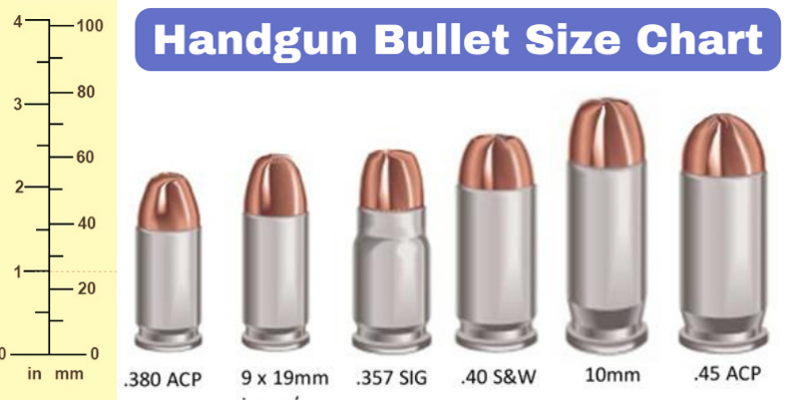
This blog post shares a popular handgun bullet size chart and basic bullet size information.
This will help you choose the right handgun caliber for your needs.
Bullet Size Basic Concepts
Before diving into the popular handgun bullet size chart, there are some basic things about bullet size. This helps to understand the bullet size chart.
A bullet size typically refers to the diameter or caliber of the bullet, which is the projectile fired from a firearm. Bullet size is usually expressed in inches or millimeters and is a crucial characteristic of a bullet that determines its compatibility with a particular gun.
Bullet size is important because it affects various factors, such as the bullet's ballistic performance, accuracy, and recoil. Different firearms are designed to accommodate specific bullet sizes, and using the correct bullet size for a gun is crucial for safety and effective shooting.
What is the difference between caliber, cartridge & bullets?
Let's know about the caliber, cartridge & how it is different from bullets.
Let's begin with understanding what caliber means.
For guns, "caliber" means the barrel's diameter and, thus, the bullet's diameter going through it, usually in inches or mm.
Caliber does not provide any information about the cartridge's speed or power. It only describes the bullet size.
The Next thing to understand about "cartridge & is how it differs from a bullet.
A "Cartridge" refers to the entire firing unit: brass case, primer, gunpowder, and projectile. The word "bullet" relates only to the action projectile shot through the barrel and hitting the target.
These were some basic terms about the bullet size. Let's move to the popular handgun bullet size comparison.
Popular Handgun Bullets Size Chart
Below we are going to share the popular handgun bullet size chart. Details for each bullet caliber include information about the size, type, recoil primer, and performance ballistics.
Note: (Please make sure to verify from the retail & brands once before buying any bullet)
9mm Bullet
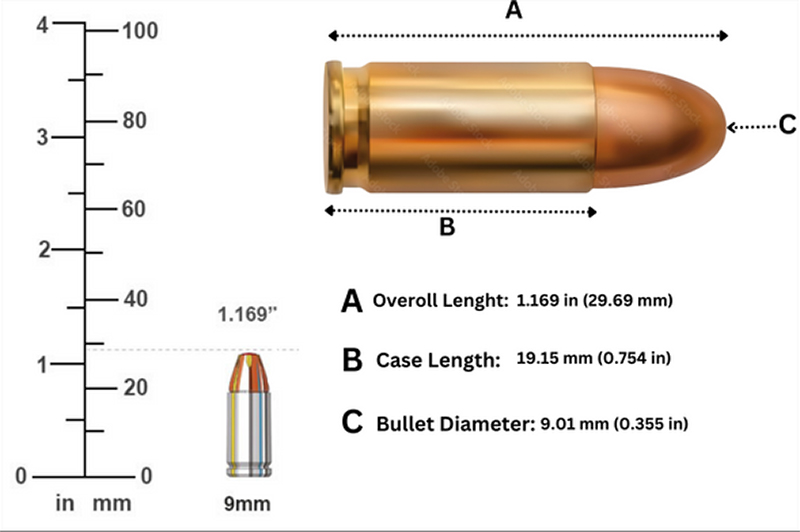
Cartridge Dimensions & Specifications
10mm Bullet
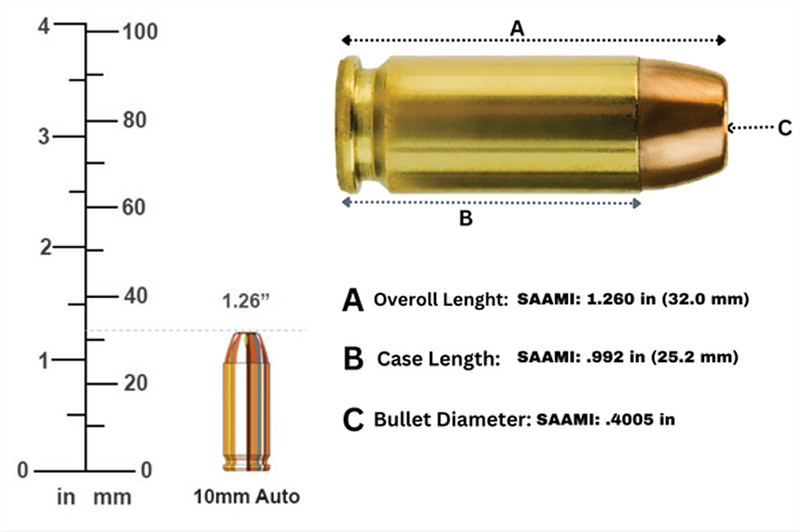
Cartridge Dimensions & Specifications
45 ACP Bullet
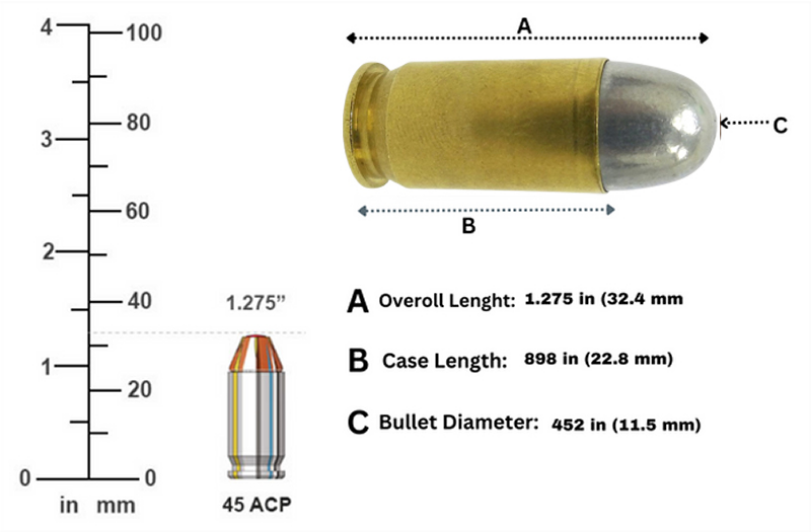
Cartridge Dimensions & Specifications
38 Special Bullet
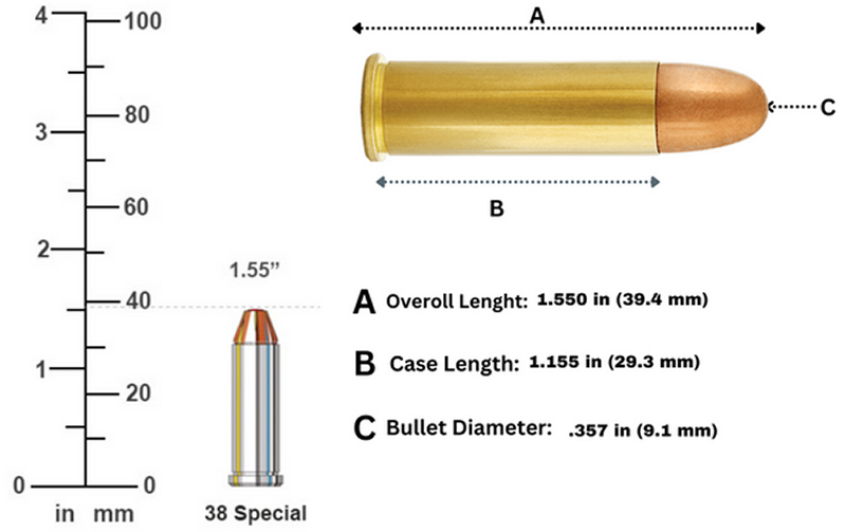
Cartridge Dimensions & Specifications
.44 Mag
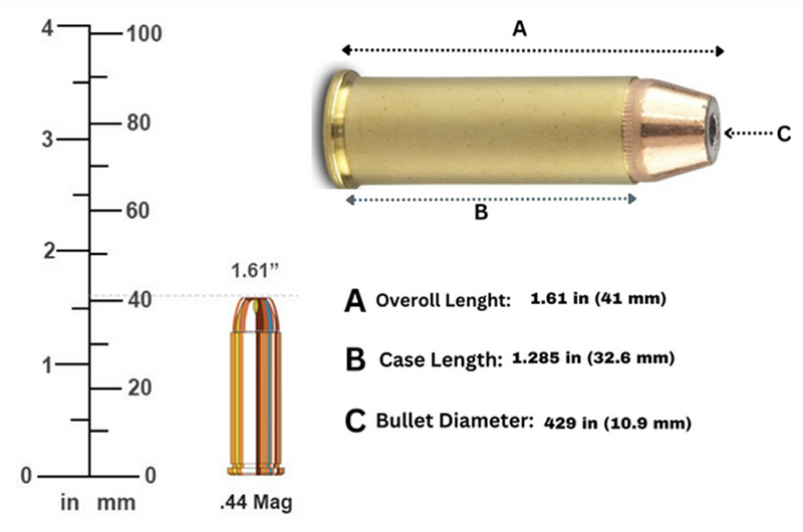
Cartridge Dimensions & Specifications
357 Magnum
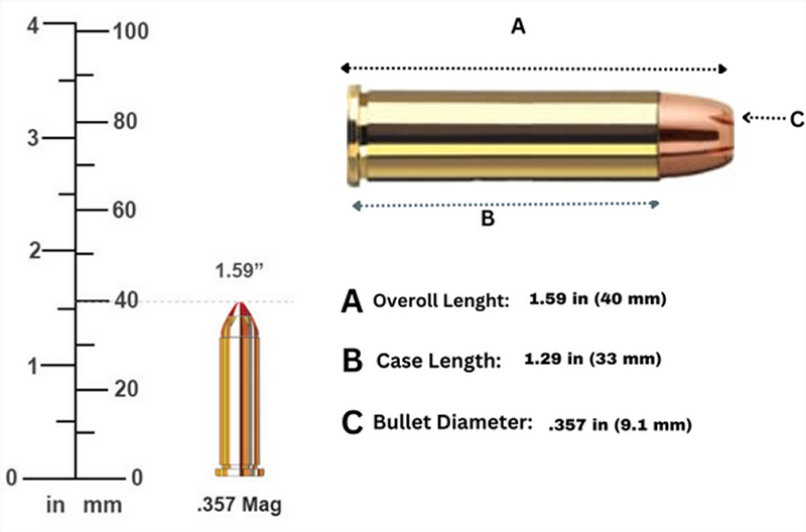
Cartridge Dimensions & Specifications
380 Auto Bullet
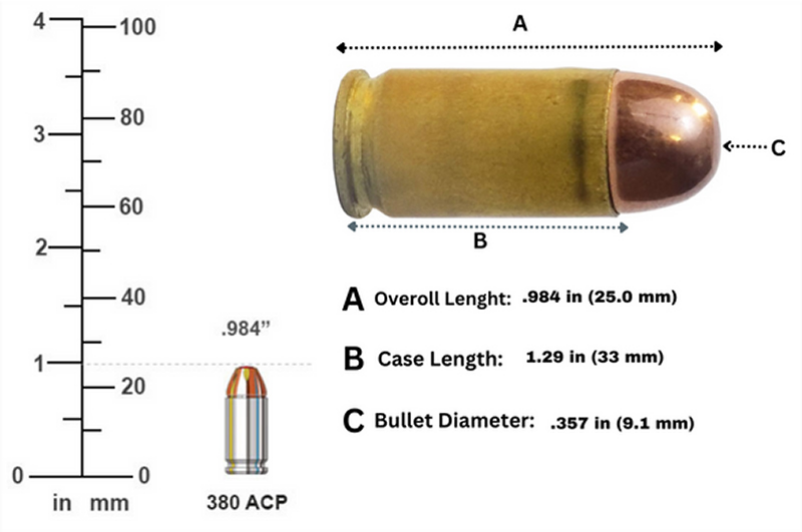
Cartridge Dimensions & Specifications
.40 S&W Bullet
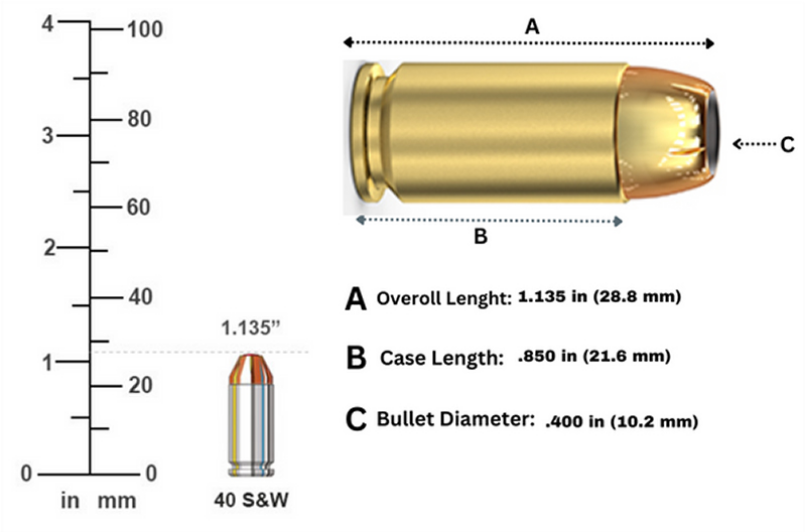
Cartridge Dimensions & Specifications
45 Colt Bullet
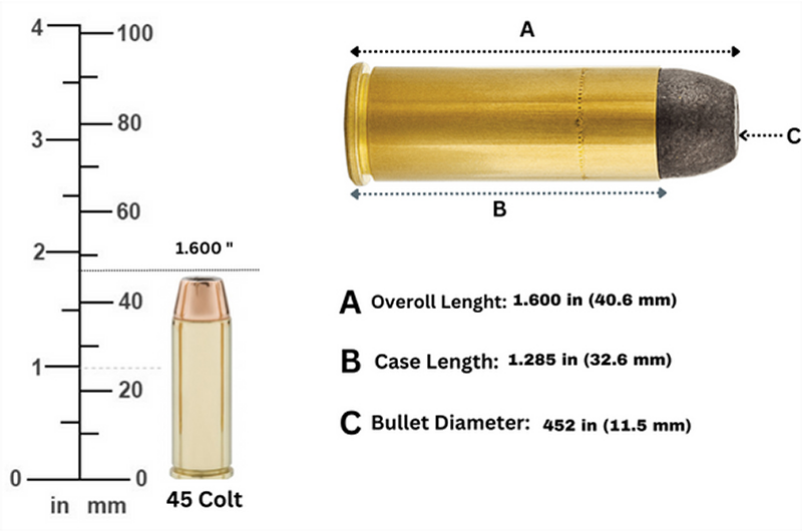
Cartridge Dimensions & Specifications
357 Sig Ammo
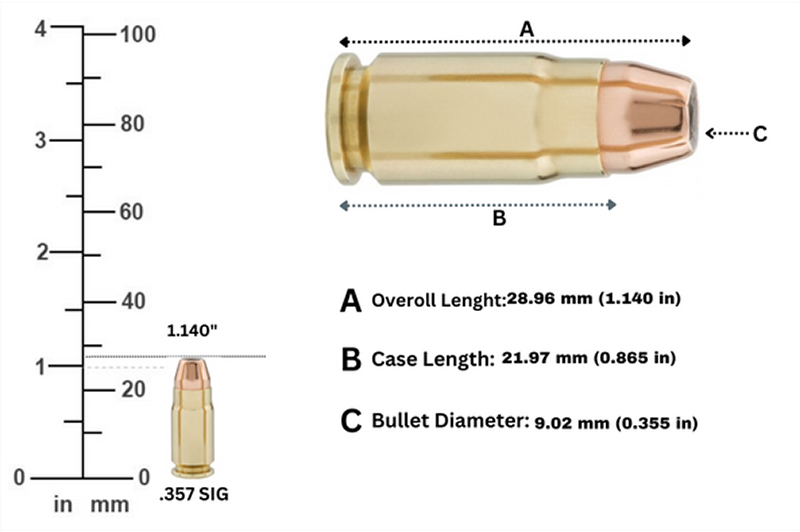
Cartridge Dimensions & Specifications
Why is bullet size important?
Bullet size, also known as bullet caliber or bullet diameter, is an important factor in the performance of a firearm and has several consequences for the firearm user. Here are a few reasons why bullet size matters:
- Accuracy: Accuracy: Bullet size can affect the accuracy of a firearm. Smaller bullets tend to be more affected by wind resistance and are less stable in flight, which can reduce accuracy at longer ranges. On the other hand, larger bullets tend to be more durable and less affected by wind, which can contribute to improved accuracy.
- Terminal ballistics: The size of the bullet can affect its terminal ballistics or performance when hitting the target. Larger bullets typically create larger wound channels on impact, causing more damage to the target. This can be especially important in hunting or self-defense situations, where the bullet's effectiveness in incapacitating the target is crucial.
- Penetration: Bullet size can also affect bullet penetration. Larger bullets can penetrate deeper into the target, which can be important in situations where the target has thick clothing, armor, or other obstacles to penetrate.
- Recoil: Bullet size can also affect the recoil or kick of a firearm. Larger bullets produce more recoil due to increased energy and momentum. This can affect the shooter's ability to control the gun and affect accuracy, especially for less experienced shooters or shooters with physical limitations.
- Legal considerations: Bullet size is also regulated by laws and regulations in many jurisdictions. Some areas have restrictions on the caliber or size of bullets that can be used for certain purposes, such as hunting or self-defense. Firearms users must know these legal considerations and select bullets that comply with local laws.
Lighter Weight Bullet Vs. Heavier Weight Bullet. Which one Is Good To Own?
There is no one-size-fits-all answer to this question, and choosing between a lighter and heavier bullet depends on your specific needs and preferences.
Still, there are some basic differences between lighter bullets vs. heavier bullets.
Lighter Weight Bullet
- Higher Velocity: Lighter bullets tend to travel at higher velocities, which can result in a smoother trajectory and less bullet drop. This can be useful for long-range shooting or when aiming at a fast-moving game.
- Less Recoil: Lighter bullets tend to have less recoil, making them easier to shoot and handle, especially for novice or smaller shooters.
- Expansion: Lighter bullets tend to expand more quickly after impact, resulting in larger wound channels and increased energy transfer, making them effective for hunting small game or varmints.
- Magazine Capacity: Lighter bullets can allow for greater magazine capacity, which can be beneficial for firearms with limited magazine space, such as handguns or some rifles.
Heavier Weight Bullet
- Increased Penetration: Heavier bullets tend to penetrate deeper into the target, which can be advantageous when hunting larger game or shooting through obstacles.
- Better Terminal Performance: Heavier bullets can retain more energy on impact and penetrate bone and tissue more efficiently, improving terminal performance and increasing the likelihood of a quick, humane kill while hunting.
- More stability in the wind: Heavier bullets are less affected by wind drift due to their higher cross-sectional density, which can be beneficial when shooting in windy conditions or at longer ranges.
- Potential for better accuracy: Heavier bullets can provide better accuracy in certain firearms due to their longer length and better stability, resulting in tighter shot groups.
Final Words
That's all, you need to know about bullet sizes. I hope this handgun bullet size chart will be helpful for your next ammo purchase.
Remember, bullet size charts are just one piece of the puzzle when it comes to firearms and ammunition. Proper firearms handling, training, and safety are equally important.
Always practice safe firearms handling, follow the manufacturer's recommendations, and seek professional advice if you are unsure about firearms and ammunition.
Disclaimer: We strive to provide the most accurate information we can. If there are any errors, please let us know. Please confirm once from the retailers & manufacturers before making any purchase.

